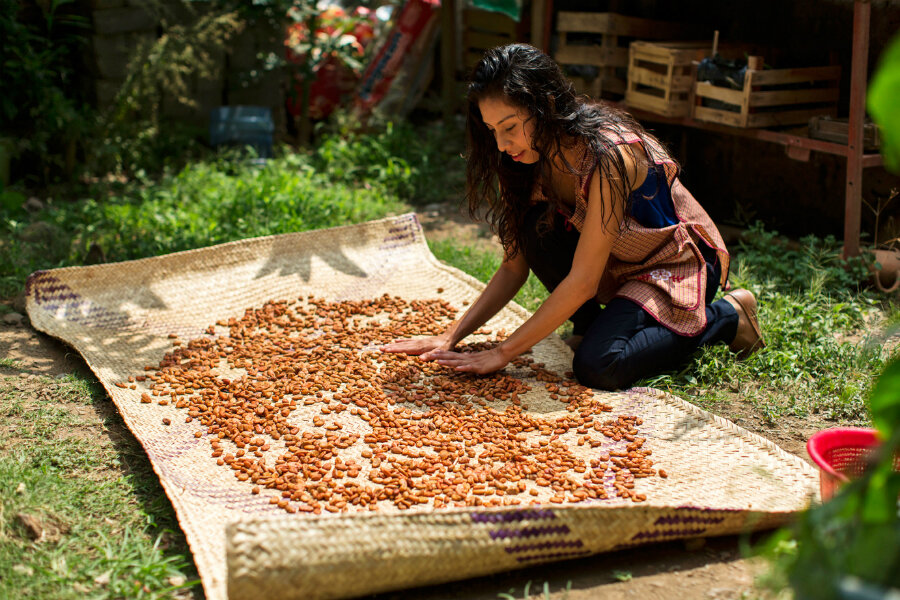A cooperative in Mexico takes on food system challenges – with chocolate
Loading...
| San Andrés Huayapam, Mexico
The warm, plummy smell of chocolate swirls through the open-air kitchen as raw cacao seeds crackle over the wood-fired comal. Deftly scooping the seeds into a palm-woven mitt, Edgardo Garcia turns to his audience, a group of seven tourists. “You’ll know the seeds are well toasted by three things: their aroma, that crackling sound, and how easily their skins slip off,” he says.
Mr. Garcia, his wife, Areli Nolasco, and their friend Elvia Velasco make up C.A.C.A.O., a chocolate cooperative in the Mexican state of Oaxaca, a region world-famous for the popular treat. The trio uses entirely traditional methods of making chocolate, following a basic recipe that is more than 2,000 years old. For visitors interested in learning how indigenous societies like the Maya and Aztecs made this delicacy, C.A.C.A.O.’s hands-on workshops are an irresistible way to spend an afternoon.
But the cooperative is about more than authentic chocolate. When it formed in 2012, the three founders were concerned about changes they were witnessing in their local food system. Mexico’s growing dependence on imported foods, especially maize, has threatened the livelihoods of rural, smallholder farmers – especially in Oaxaca, one of the country’s poorest and least developed states. Garcia, Ms. Nolasco, and Ms. Velasco wanted to return to locally produced, culturally appropriate foods.
“We decided to do this through chocolate, because chocolate maintains a very vivid presence in our culture,” Garcia says. “We wanted to revive the traditional methods of making chocolate, and at the same time reclaim the ability our ancestors had to feed themselves.”
By selecting ingredients from local, smallholder farmers, the trio aims to effect changes to a food system that is increasingly connected to global supply chains, and increasingly linked to social issues like migration and public health. Despite the growing abundance of imported foods, even in the country’s most rural areas, about 28 million Mexicans experience food insecurity, according to the National Council for the Evaluation of Social Development Policy.
In Oaxaca, where 2 out of 3 people live in poverty, access to nutritious food can be a particular problem. “Food insecurity is linked to the decrease in local food production and the weakening of rural economies,” says Mauricio del Villar, director of social economy for Puente a la Salud Comunitaria, a nonprofit in Oaxaca that promotes sustainable food systems. (Nolasco works as a community nutritionist for Puente.)
Mr. del Villar points to rural-to-urban migration as a root cause of these issues. “The average age of the Oaxacan farmer is 55 years,” he says. “The younger generation has no interest in remaining in their rural hometowns, mainly because they’re seeking jobs and incomes that will give them a better quality of life.”
Moreover, researchers say the consumption of imported, processed foods can lead to health problems.
For organizations like C.A.C.A.O. and Puente, the solution to these issues lies in making small-scale farming a more viable livelihood, thereby strengthening rural economies and increasing access to healthier foods. The cooperative has carefully built a local network of farmers and producers from which it sources cacao, honey, and cinnamon – all traditional ingredients in pre-Hispanic chocolate – as well as other products like coffee and amaranth, an ancient grain that is said to be highly nutritious.
“By working directly with farmers, we help create a fairer system in which they have the ability to set their own prices and conditions,” Garcia says. “For us, it’s more than a business relationship: It’s a relationship built on trust and the shared goal of working toward a better life.”
“The cooperative’s approach strengthens farming families and their communities,” del Villar adds.
Garcia, Nolasco, and Velasco are also focused on creating a chocolate that is far less sweet than the modern varieties typically sold in stores and markets in Oaxaca. “Commercial Oaxacan chocolate contains up to three-fourths sugar,” Nolasco says. “We wanted to make a healthier chocolate with natural ingredients.” In a region where many people eat chocolate on a daily basis, providing a more nutritious alternative can make a difference.
Although its business is still limited to what three pairs of hands and three minds can accomplish in the hours not spent working at other jobs or raising young families, the trio has plans to grow. It recently took to Kickstarter – raising $2,920 in much-needed funds – and it often appears at events in Oaxaca's capital city to speak about its mission.
“We hope to form relationships with people all over the world who support our goals, and find people interested in distributing and buying our products locally,” Garcia says. “This way we continue building a more sustainable, just economic system that we know is possible.”







